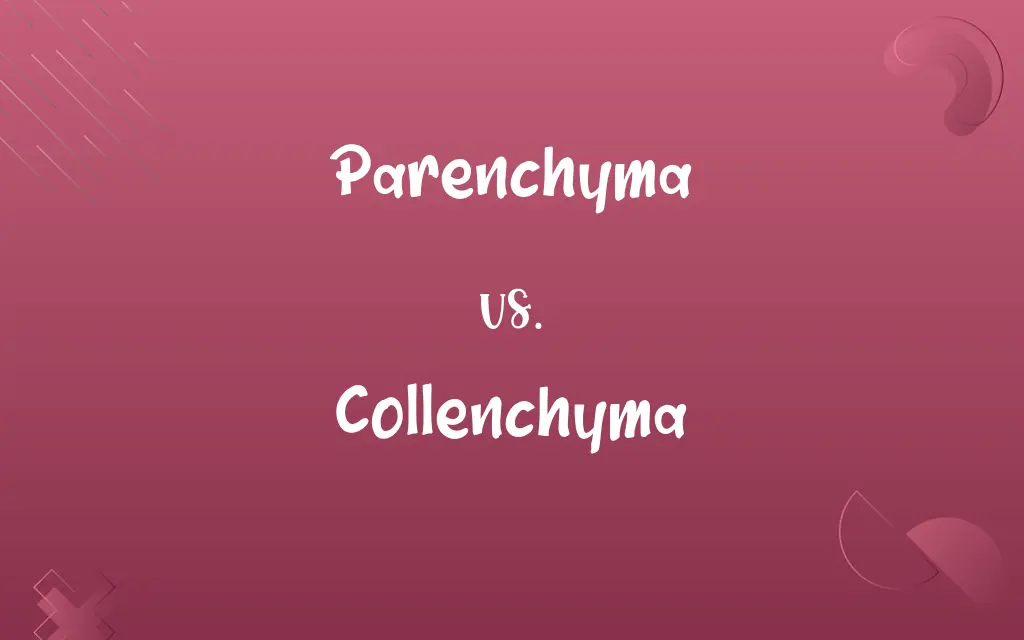Parenchyma vs. Collenchyma: Know the Difference

By Hifza Nasir & Dua Fatima || Published on April 10, 2024
Parenchyma cells are involved in storage, photosynthesis, and regeneration, featuring thin walls and large vacuoles, while collenchyma provides flexible and mechanical support with thicker, uneven walls.

Key Differences
Parenchyma cells, found throughout the plant, are pivotal for functions like storage, photosynthesis, and regeneration due to their thin walls and large vacuoles. On the other hand, collenchyma cells specialize in providing support and flexibility to growing parts of the plant, characterized by their thicker, uneven cell walls.
Dua Fatima
Apr 10, 2024
The presence of large vacuoles in parenchyma cells aids in the storage of nutrients and water, essential for the plant's growth and survival. Collenchyma, whereas, contributes to the mechanical strength of the plant, allowing it to withstand various forces.
Hifza Nasir
Apr 10, 2024
Parenchyma cells can also play a role in the healing and regeneration of plant tissues, a capability not prominently featured in collenchyma cells. Instead, collenchyma enhances the plant's structural integrity, especially in stems and leaves, ensuring durability and flexibility.
Hifza Nasir
Apr 10, 2024
In terms of their distribution within the plant, parenchyma cells are more universally present in both primary and secondary plant tissues. Collenchyma cells, however, are primarily located in areas that require support without restricting growth, such as young stems and petioles.
Shumaila Saeed
Apr 10, 2024
While parenchyma cells have the ability to change their function and differentiate into other cell types under certain conditions, collenchyma cells are more specialized and less versatile in their roles within the plant structure.
Dua Fatima
Apr 10, 2024
ADVERTISEMENT
Comparison Chart
Primary Function
Storage, photosynthesis, regeneration
Mechanical support and flexibility
Hifza Nasir
Apr 10, 2024
Location in Plants
Throughout the plant in both primary and secondary tissues
Primarily in young stems and petioles
Dua Fatima
Apr 10, 2024
Capacity for Differentiation
High, can differentiate into other cell types
Low, specialized in their function
Shumaila Saeed
Apr 10, 2024
ADVERTISEMENT
Parenchyma and Collenchyma Definitions
Parenchyma
Fundamental plant tissue involved in various functions including storage and photosynthesis.
The parenchyma cells in leaves are crucial for photosynthesis.
Hifza Nasir
Mar 06, 2024
Collenchyma
Specialized for providing mechanical support and flexibility.
Collenchyma cells in the stem allow plants to bend without breaking.
Hifza Nasir
Mar 06, 2024
Parenchyma
Characterized by thin cell walls and large vacuoles.
The large vacuoles in parenchyma cells store nutrients and water.
Hifza Nasir
Mar 06, 2024
Collenchyma
Features thicker, uneven cell walls.
The uneven cell walls of collenchyma enhance the plant's strength.
Dua Fatima
Mar 06, 2024
Parenchyma
Capable of differentiating into other cell types under certain conditions.
Parenchyma cells can differentiate into xylem or phloem cells during plant growth.
Dua Fatima
Mar 06, 2024
ADVERTISEMENT
Collenchyma
Located primarily in young stems and petioles.
Collenchyma cells support young leaves and flowers.
Hifza Nasir
Mar 06, 2024
Parenchyma
Plays a significant role in the healing and regeneration of plant tissues.
After leaf damage, parenchyma cells aid in tissue recovery.
Hifza Nasir
Mar 06, 2024
Collenchyma
Does not play a direct role in photosynthesis or storage.
Unlike parenchyma, collenchyma focuses on support.
Dua Fatima
Mar 06, 2024
Parenchyma
Universally present in both primary and secondary plant tissues.
Parenchyma cells in the stem assist in the storage of starch.
Dua Fatima
Mar 06, 2024
Collenchyma
Specialized and less versatile compared to parenchyma.
Collenchyma cells maintain the structure of growing plant parts.
Hifza Nasir
Mar 06, 2024
Parenchyma
The soft cellular substance of the tissues of plants and animals, like the pulp of leaves, the soft tissue of glands, and the like.
Hifza Nasir
Mar 05, 2024
Collenchyma
A supportive tissue of plants, consisting of elongated living cells with unevenly thickened walls.
Hifza Nasir
Mar 05, 2024
Parenchyma
The primary tissue of higher plants composed of thin-walled cells that remain capable of cell division even when mature; constitutes the greater part of leaves, roots, the pulp of fruits, and the pith of stems
Shumaila Saeed
Mar 05, 2024
Collenchyma
A tissue of vegetable cells which are thickend at the angles and (usually) elongated.
Hifza Nasir
Mar 05, 2024
Repeatedly Asked Queries
What is the main function of parenchyma cells?
The main functions include storage, photosynthesis, and regeneration.
Dua Fatima
Apr 10, 2024
Can parenchyma cells differentiate into other types of cells?
Yes, they can differentiate into other cell types under certain conditions.
Hifza Nasir
Apr 10, 2024
Can collenchyma cells store nutrients and water?
While they may contribute indirectly to support, their main function is not storage, unlike parenchyma cells.
Dua Fatima
Apr 10, 2024
Do collenchyma cells have a role in photosynthesis?
No, their primary role is to provide mechanical support and flexibility, not photosynthesis.
Dua Fatima
Apr 10, 2024
Are collenchyma cells found in both primary and secondary tissues?
No, they are primarily located in areas requiring support during growth, such as young stems.
Hifza Nasir
Apr 10, 2024
Are parenchyma cells important for plant growth?
Yes, they are crucial for storage, photosynthesis, and regeneration, affecting overall plant growth.
Hifza Nasir
Apr 10, 2024
What distinguishes collenchyma cells from parenchyma cells in terms of cell wall?
Collenchyma cells have thicker, uneven cell walls, while parenchyma cells have thin, flexible walls.
Shumaila Saeed
Apr 10, 2024
Where are collenchyma cells primarily found?
They are found in young stems and petioles, providing mechanical support.
Hifza Nasir
Apr 10, 2024
How do collenchyma cells enhance a plant's flexibility?
Their thicker cell walls provide strength while allowing flexibility, enabling plants to bend without breaking.
Hifza Nasir
Apr 10, 2024
How do parenchyma cells contribute to plant healing?
They play a significant role in the healing and regeneration of plant tissues.
Hifza Nasir
Apr 10, 2024
Share this page
Link for your blog / website
HTML
Link to share via messenger
About Author
Written by
Hifza NasirCo-written by
Dua Fatima





































































